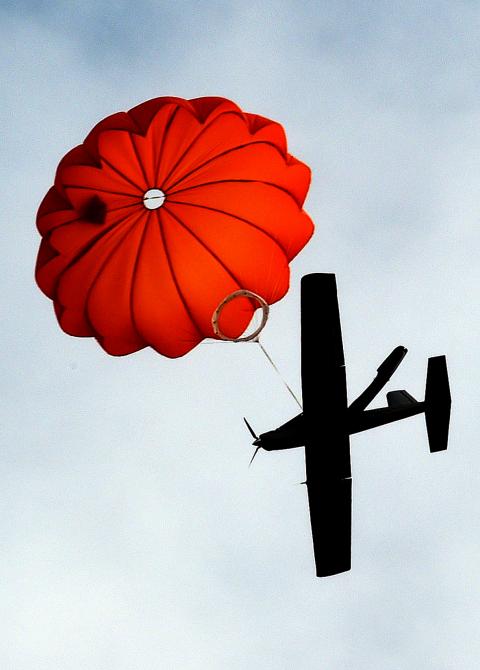The nation’s defense and air reconnaissance capabilities have been significantly enhanced with unmanned aerial vehicles (UAVs) and other cutting-edge systems and devices, which were unveiled yesterday by the Chungshan Institute of Science & Technology (CSIST).
The demonstration of remote-controlled aircraft and new pilot-training simulators took place at the institute’s Aeronautical Systems Research Division in Greater Taichung.
A small, 5kg battery-powered drone, named “Cardinal,” can be launched by hand and has a one-hour flight time and a range of 8km, division officials said. It is piloted by remote control by an operator via wireless link at a mobile station, they said.

Photo: Chien Jung-fong, Taipei Times
Division director Ma Wan-june (馬萬鈞) said the small aircraft has the advantages of portability, ease of operation and the capability to gather aerial intelligence.
“Taiwan’s indigenous UAV’s have bolstered the range and capacity of the military’s air reconnaissance and surveillance missions, and also assist the navy and Coast Guard Administration to defend our marine territories,” he said.
“The aircraft can also be used for disaster relief and rescue missions; aerial photography for assessing environmental changes; monitoring of forest and mountain regions; and management of agriculture and water resources,” Ma said.
The Cardinal yesterday was launched by a handler who flew it over a field as it provided a continuous feed of aerial imaging signals, GPS information and other data to the computers at its ground control station.
After popping open a parachute, the drone touched down for retrieval and reuse.
“It is outfitted with an electro-optical and infrared imaging system, which can rotate 360o for wide-angle coverage. It can also carry out missions at night with its infrared bands,” Ma said.
A bigger drone called the “Albatross” weighs 317kg, has an 8m wingspan, a flight time of 10 hours and a 150km range, he said.
The Albatross can also carry heavier payloads, he said.
He said all of the drone fleet models were developed by the division, with the production and integration of components coming from more than 20 Taiwanese companies, generating NT$1.34 billion (US$42.95 million) in derived business revenues.
Officials at yesterday’s demonstration would not confirm whether the drones are able to carry missiles and other weapons.
They said a technical service team would be established shortly to allow government agencies access to the drone fleet for various uses.
The demonstration also included a flight simulator for training pilots, combat simulators for soldiers and the TFE-1042 turbofan engine, which can be converted into an electrical generator.
The TFE-1042 was developed to power the Indigenous Defense Fighter (IDF) jets and is now targeted for the “green energy” sector, as the engine can burn methane gas from biodegradable garbage and animal waste.
Ma said the institute has had a lot of inquiries from around the world for the engine, while estimating potential derived revenue to reach about NT$40 billion in the coming years.

TRAGEDY STRIKES TAIPEI: The suspect died after falling off a building after he threw smoke grenades into Taipei Main Station and went on a killing spree in Zhongshan A 27-year-old suspect allegedly threw smoke grenades in Taipei Main Station and then proceeded to Zhongshan MRT Station in a random killing spree that resulted in the death of the suspect and two other civilians, and seven injured, including one in critical condition, as of press time last night. The suspect, identified as a man surnamed Chang Wen (張文), allegedly began the attack at Taipei Main Station, the Taipei Fire Department said, adding that it received a report at 5:24pm that smoke grenades had been thrown in the station. One man in his 50s was rushed to hospital after a cardiac arrest

A car bomb killed a senior Russian general in southern Moscow yesterday morning, the latest high-profile army figure to be blown up in a blast that came just hours after Russian and Ukrainian delegates held separate talks in Miami on a plan to end the war. Kyiv has not commented on the incident, but Russian investigators said they were probing whether the blast was “linked” to “Ukrainian special forces.” The attack was similar to other assassinations of generals and pro-war figures that have either been claimed, or are widely believed to have been orchestrated, by Ukraine. Russian Lieutenant General Fanil Sarvarov, 56, head

SAFETY FIRST: Double the number of police were deployed at the Taipei Marathon, while other cities released plans to bolster public event safety Authorities across Taiwan have stepped up security measures ahead of Christmas and New Year events, following a knife and smoke bomb attack in Taipei on Friday that left four people dead and 11 injured. In a bid to prevent potential copycat incidents, police deployments have been expanded for large gatherings, transport hubs, and other crowded public spaces, according to official statements from police and city authorities. Taipei Mayor Chiang Wan-an (蔣萬安) said the city has “comprehensively raised security readiness” in crowded areas, increased police deployments with armed officers, and intensified patrols during weekends and nighttime hours. For large-scale events, security checkpoints and explosives

PUBLIC SAFETY: The premier said that security would be tightened in transport hubs, while President Lai commended the public for their bravery The government is to deploy more police, including rapid response units, in crowded public areas to ensure a swift response to any threats, President William Lai (賴清德) said yesterday after a knife attack killed three people and injured 11 in Taipei the previous day. Lai made the remarks following a briefing by the National Police Agency on the progress of the investigation, saying that the attack underscored the importance of cooperation in public security between the central and local governments. The attack unfolded in the early evening on Friday around Taipei Main Station’s M7 exit and later near the Taipei MRT’s Zhongshan